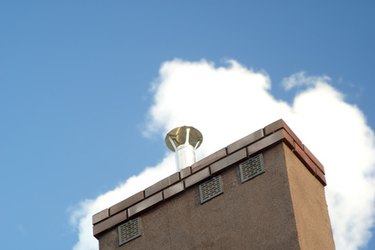
While it is logistically feasible to burn wood chips in a pellet stove, it is not a very easy or practical choice. Pellet stoves are designed to utilize specially made pellets; to feed them automatically into the combustion chamber; to consume the fuel material very efficiently and leave a minimum of residual ash or smoke. Wood chips can be burnt in a pellet stove, but only at the sacrifice of the automatic feed system, the efficient burn, and the low volume of waste products.
How You Can Burn Wood Chips
Video of the Day
The initial problem with burning wood chips in a pellet stove originates with the inexact sizes, shapes, densities and moisture of the chips. The pellet stove is intended to be fueled with relatively uniform pellets via an auger, which will carry the combustible bits from an external hopper along a conveyor device and into the fire box or combustion chamber. Wood chips added to the hopper will clog the auger, cause blockages or pour in too fast. If your particular stove offers direct access to the combustion chamber, you can shovel wood chips directly into the combustion area to be burnt. Unfortunately, this negates one of the main benefits of the pellet stoves, which is the automated refilling capability. If you are filling the combustion chamber by hand, then you must remain near the stove to monitor the temperatures generated and to refill the chamber as necessary. Not all pellet stoves are designed to permit hand filling, if yours is not, then you will have to use only wood chips that are small enough to pass easily through the auger tube where pellets would normally flow, commonly a 2-inch diameter.
Video of the Day
While hand filling might work in an emergency situation, it is not feasible over a long period of time. It would take a great deal of time to pulverize the chips enough to make them flow into the stove readily and someone would need to be present constantly to monitor the need for additional fuel input.
Reasons Not to Use Wood Chips

Other problems associated with burning wood chips in a pellet stove include those of uneven or inefficient burn, and those of greatly increased waste products due to the inefficient burn. Unlike pellets, which are created to be of a uniform density and moisture, wood chips will burn at different rates. The level of combustion heat ideal for one density of wood will cause other pieces to burn too slowly, resulting in decreased heat generated by the stove. When uneven burning is combined with increased moisture in the wood chips, much more waste will be produced in the form of ash, creosote and smoke.
Creosote buildup has been linked with dangerous chimney fires. Excessive wood smoke emissions are illegal in some localities. And ash must be disposed of properly so as not to facilitate the formation of lye, a dangerous, caustic chemical.
Not Very Easy, Not Very Effective

While it is possible to burn wood chips in most pellet stoves, it is difficult to get the chips into the stove, tricky to maintain an even and desired temperature while burning them, and troublesome to deal with the resulting waste products.